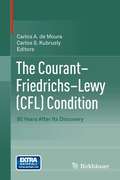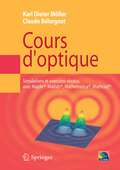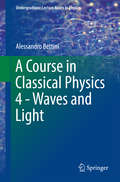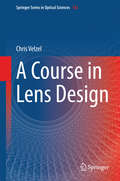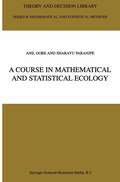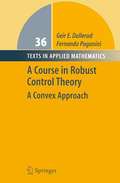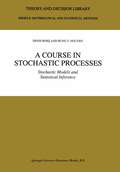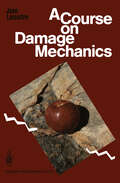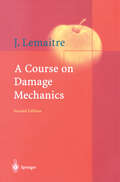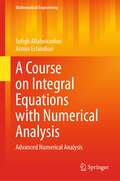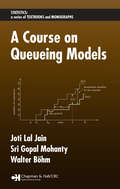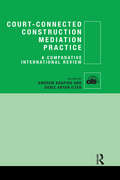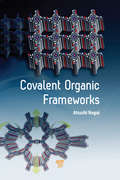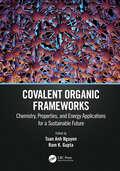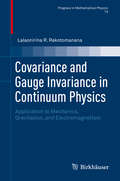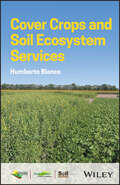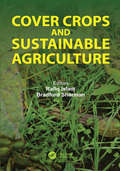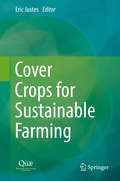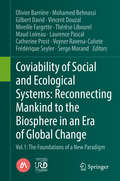- Table View
- List View
The Courant–Friedrichs–Lewy (CFL) Condition: 80 Years After Its Discovery
by Carlos A. Moura and Carlos S. KubruslyThis volume comprises a carefully selected collection of articles emerging from and pertinent to the 2010 CFL-80 conference in Rio de Janeiro, celebrating the 80th anniversary of the Courant-Friedrichs-Lewy (CFL) condition. A major result in the field of numerical analysis, the CFL condition has influenced the research of many important mathematicians over the past eight decades, and this work is meant to take stock of its most important and current applications.The Courant–Friedrichs–Lewy (CFL) Condition: 80 Years After its Discovery will be of interest to practicing mathematicians, engineers, physicists, and graduate students who work with numerical methods.
Cours d'optique: Simulations et exercices résolus avec Maple®, Matlab®, Mathematica®, Mathcad®
by Karl Dieter Moeller Claude BélorgeotCet ouvrage s'adresse aux étudiants des niveaux L et M de l'université ainsi qu'aux ingénieurs désireux d'approfondir certains sujets. Il couvre tous les thèmes d'un cours d'optique traditionnel, de l'optique géométrique à l'holographie, en passant par les interférences, la diffraction, la cohérence et l'utilisation de la transformée de Fourier pour la spectroscopie. L'exposé est développé à partir de modèles mathématiques dérivant de situations typiques et d'exemples fondamentaux qui sont présentés sous forme de programmes informatiques prêts à être mis en œuvre. Ces programmes sont aussi disponibles sur le CD accompagnant l'ouvrage, pour chacun des environnements de programmation scientifiques suivants: Matlab, Maple, Mathematica et Mathcad. Ainsi, le lecteur pourra modifier les paramètres des exemples proposés pour les adapter à de nouvelles situations. (Une mise à jour de ces programmes pour Mathematica Version 6 est disponible sur le site internet de l'auteur (voir rubrique contenu électronique à droite)). L'originalité de cet ouvrage consiste en une présentation succincte des équations fondamentales de l'optique sous forme de rappels de cours, illustrées par des exemples développés et des programmes les mettant en œuvre. Il est ainsi particulièrement adapté à l'auto-apprentissage. Il sera aussi très utile pour mettre en œuvre des travaux pratiques et des simulations sur ordinateur.
A Course in Classical Physics 4 - Waves and Light (Undergraduate Lecture Notes in Physics)
by Alessandro BettiniThis fourth volume of a four-volume textbook covers the oscillations of systems with one or more degrees of freedom; the concept of waves, focusing on light and sound; phase and group velocities, their physical meaning, and their measurement; diffraction and interference of light; polarization phenomena; and the formation of images in the eye and in optical instruments.The textbook as a whole covers electromagnetism, mechanics, fluids and thermodynamics, and waves and light, and is designed to reflect the typical syllabus during the first two years of a calculus-based university physics program. Throughout all four volumes, particular attention is paid to in-depth clarification of conceptual aspects, and to this end the historical roots of the principal concepts are traced. Emphasis is also consistently placed on the experimental basis of the concepts, highlighting the experimental nature of physics. Whenever feasible at the elementary level, concepts relevant to more advanced courses in quantum mechanics and atomic, solid state, nuclear, and particle physics are included. The textbook offers an ideal resource for physics students, lecturers and, last but not least, all those seeking a deeper understanding of the experimental basics of physics.
A Course in Lens Design (Springer Series in Optical Sciences #183)
by Chris VelzelA Course in Lens Design is an instruction in the design of image-forming optical systems. It teaches how a satisfactory design can be obtained in a straightforward way. Theory is limited to a minimum, and used to support the practical design work. The book introduces geometrical optics, optical instruments and aberrations. It gives a description of the process of lens design and of the strategies used in this process. Half of its content is devoted to the design of sixteen types of lenses, described in detail from beginning to end. This book is different from most other books on lens design because it stresses the importance of the initial phases of the design process: (paraxial) lay-out and (thin-lens) pre-design. The argument for this change of accent is that in these phases much information can be obtained about the properties of the lens to be designed. This information can be used in later phases of the design. This makes A Course in Lens Design a useful self-study book and a suitable basis for an introductory course in lens design. The mathematics mainly used is college algebra, in a few sections calculus is applied. The book could be used by students of engineering and technical physics and by engineers and scientists.
A Course in Mathematical and Statistical Ecology (Theory and Decision Library B #42)
by Anil Gore S.A. ParanjpeA Course in Mathematical and Statistical Ecology
A Course in Robust Control Theory: A Convex Approach (Texts in Applied Mathematics #36)
by Geir E. Dullerud Fernando PaganiniDuring the 90s robust control theory has seen major advances and achieved a new maturity, centered around the notion of convexity. The goal of this book is to give a graduate-level course on this theory that emphasizes these new developments, but at the same time conveys the main principles and ubiquitous tools at the heart of the subject. Its pedagogical objectives are to introduce a coherent and unified framework for studying the theory, to provide students with the control-theoretic background required to read and contribute to the research literature, and to present the main ideas and demonstrations of the major results. The book will be of value to mathematical researchers and computer scientists, graduate students planning to do research in the area, and engineering practitioners requiring advanced control techniques.
A Course in Stochastic Processes: Stochastic Models and Statistical Inference (Theory and Decision Library B #34)
by Denis Bosq Hung T. NguyenThis text is an Elementary Introduction to Stochastic Processes in discrete and continuous time with an initiation of the statistical inference. The material is standard and classical for a first course in Stochastic Processes at the senior/graduate level (lessons 1-12). To provide students with a view of statistics of stochastic processes, three lessons (13-15) were added. These lessons can be either optional or serve as an introduction to statistical inference with dependent observations. Several points of this text need to be elaborated, (1) The pedagogy is somewhat obvious. Since this text is designed for a one semester course, each lesson can be covered in one week or so. Having in mind a mixed audience of students from different departments (Math ematics, Statistics, Economics, Engineering, etc.) we have presented the material in each lesson in the most simple way, with emphasis on moti vation of concepts, aspects of applications and computational procedures. Basically, we try to explain to beginners questions such as "What is the topic in this lesson?" "Why this topic?", "How to study this topic math ematically?". The exercises at the end of each lesson will deepen the stu dents' understanding of the material, and test their ability to carry out basic computations. Exercises with an asterisk are optional (difficult) and might not be suitable for homework, but should provide food for thought.
A Course on Damage Mechanics
by Jean LemaitreA new branch of science usually develops thus. Somebody publishes the basic ideas. Hesitatingly at first, then little by little, other original contributions appear, until a certain threshold is reached. Then, overview articles are printed, conferences are held, and a first mention is made in textbooks, until specialized monographs are written. Continuum darnage mechanics has reached that status now. To analyze or, if possible, to predict the failure of machine parts or other structures is one of the main goals of engineering science. Consequently fracture mechanics became one of its leading branches. It was based on the analysis of existing cracks. However, especially under conditions of cyclic loading, this might be too late to prevent a disaster. Therefore, the question regarding the precursory state, that is, the evolution of intemal darnage before macrocracks become visible, was then posed. One of the successful approaches to the problern was Weibull's theory which examined, in a statistical manner, the "weakest link" in the material volume under consideration. Unfortunately it proved too difficult mathematically to be applied to complicated parts or structures. Therefore it was highly appreciated by the scientific of material community when L. M. Kachanov published in 1958 a simple model darnage which subsequently could be extended to brittle elastic, plastic or viscous materials under all conditions of uniaxial or multiaxial, simple or cyclic loadings, so that it may be considered nearly universal.
A Course on Damage Mechanics
by Jean LemaitreThis second, corrected and enlarged edition teaches macroscopic modeling for the design, processing, testing, and control of mechanical components in engineering, and also includes the damage of interfaces and statistical damage analysis with microdefects. The first chapter deals with the phenomenology of damage, while the second couples damage to strains before going on to cover the three-dimensional situation. Chapter 3 is devoted to kinetic laws of damage evolution used by the author to unify many models, and the book is rounded off with several methods for predicting crack initiation. Detailed calculations and many exercises help students to apply the powerful techniques to practical problems in engineering.
A Course on Integral Equations with Numerical Analysis: Advanced Numerical Analysis (Mathematical Engineering)
by Tofigh Allahviranloo Armin EsfandiariThis book suggests that the numerical analysis subjects’ matter are the important tools of the book topic, because numerical errors and methods have important roles in solving integral equations. Therefore, all needed topics including a brief description of interpolation are explained in the book. The integral equations have many applications in the engineering, medical, and economic sciences, so the present book contains new and useful materials about interval computations including interval interpolations that are going to be used in interval integral equations. The concepts of integral equations are going to be discussed in two directions, analytical concepts, and numerical solutions which both are necessary for these kinds of dynamic systems. The differences between this book with the others are a full discussion of error topics and also using interval interpolations concepts to obtain interval integral equations. All researchers and students in the field of mathematical, computer, and also engineering sciences can benefit the subjects of the book.
A Course on Queueing Models (Statistics: Textbooks and Monographs)
by Joti Lal JainThe application of engineering principles in divergent fields such as management science and communications as well as the advancement of several approaches in theory and computation have led to growing interest in queueing models, creating the need for a comprehensive text. Emphasizing Markovian structures and the techniques that occur in differen
Court-Connected Construction Mediation Practice: A Comparative International Review
by Andrew Agapiou Deniz Artan IlterThe value of mediation has been widely acknowledged worldwide, as shown by the number of jurisdictions in which the courts enforce obligations on parties to negotiate and adopt mediation to settle construction disputes. This book examines the expansion and development of court-connected construction mediation provisions across a number of jurisdictions, including the England and Wales, the USA, South Africa and Hong Kong. It includes contributions from academics and professionals in six different countries to produce a truly international comparative study, which is of high importance to construction managers as well as legal professionals.
Court-Connected Construction Mediation Practice: A Comparative International Review
by Andrew Agapiou Deniz Artan IlterThe value of mediation has been widely acknowledged worldwide, as shown by the number of jurisdictions in which the courts enforce obligations on parties to negotiate and adopt mediation to settle construction disputes. This book examines the expansion and development of court-connected construction mediation provisions across a number of jurisdictions, including the England and Wales, the USA, South Africa and Hong Kong. It includes contributions from academics and professionals in six different countries to produce a truly international comparative study, which is of high importance to construction managers as well as legal professionals.
Covalent Organic Frameworks
by Atsushi NagaiRational synthesis of extended arrays of organic matter in bulk, solution, crystals, and thin films has always been a paramount goal of chemistry. The classical synthetic tools to obtain long-range regularity are, however, limited to noncovalent interactions, which usually yield structurally more random products. Hence, a combination of porosity and regularity in organic covalently bonded materials requires not only the design of molecular building blocks that allow for growth into a nonperturbed, regular geometry but also a condensation mechanism that progresses under reversible, thermodynamic, self-optimizing conditions. Covalent organic frameworks (COFs), a variety of 2D crystalline porous materials composed of light elements, resemble an sp2-carbon-based graphene sheet but have a different molecular skeleton formed by orderly linkage of building blocks to constitute a flat organic sheet. COFs have attracted considerable attention in the past decade because of their versatile applications in gas storage and separation, catalysis, sensing, drug delivery, and optoelectronic materials development. Compared to other porous materials, COFs allow for atomically precise control of their architectures by changing the structure of their building blocks, whereby the shapes and sizes of their pores can be well-tuned. Covalent Organic Frameworks is a compilation of different topics in COF research, from COF design and synthesis, crystallization, and structural linkages to the theory of gas sorption and various applications of COFs, such as heterogeneous catalysts, energy storage (e.g., semiconductors and batteries), and biomedicine. This handbook will appeal to anyone interested in nanotechnology and new materials of gas adsorption and storage, heterogeneous catalysts, electronic devices, and biomedical devices.
Covalent Organic Frameworks
by Atsushi NagaiRational synthesis of extended arrays of organic matter in bulk, solution, crystals, and thin films has always been a paramount goal of chemistry. The classical synthetic tools to obtain long-range regularity are, however, limited to noncovalent interactions, which usually yield structurally more random products. Hence, a combination of porosity and regularity in organic covalently bonded materials requires not only the design of molecular building blocks that allow for growth into a nonperturbed, regular geometry but also a condensation mechanism that progresses under reversible, thermodynamic, self-optimizing conditions. Covalent organic frameworks (COFs), a variety of 2D crystalline porous materials composed of light elements, resemble an sp2-carbon-based graphene sheet but have a different molecular skeleton formed by orderly linkage of building blocks to constitute a flat organic sheet. COFs have attracted considerable attention in the past decade because of their versatile applications in gas storage and separation, catalysis, sensing, drug delivery, and optoelectronic materials development. Compared to other porous materials, COFs allow for atomically precise control of their architectures by changing the structure of their building blocks, whereby the shapes and sizes of their pores can be well-tuned. Covalent Organic Frameworks is a compilation of different topics in COF research, from COF design and synthesis, crystallization, and structural linkages to the theory of gas sorption and various applications of COFs, such as heterogeneous catalysts, energy storage (e.g., semiconductors and batteries), and biomedicine. This handbook will appeal to anyone interested in nanotechnology and new materials of gas adsorption and storage, heterogeneous catalysts, electronic devices, and biomedical devices.
Covalent Organic Frameworks: Chemistry, Properties, and Energy Applications for a Sustainable Future
by Tuán Anh Nguyen Ram K. GuptaCovalent organic frameworks-based nanomaterials have emerged as promising candidates for energy applications owing to their superior electrochemical properties, surface area, nano-device integration, multifunctionality, printability, and mechanical flexibility. This book provides fundamentals, various synthesis approaches, and applications of covalent organic frameworks-based nanomaterials and their composites for generating energy. The main objective of this book is to provide current, state-of-the-art knowledge about covalent organic frameworks-based nanomaterials and their composites for supercapacitors, batteries, photovoltaics, and fuel cells, covering almost the entire spectrum in the energy field under one title. Aimed at widening our fundamental understanding of covalent organic frameworks and mechanisms for realization and advancement in devices with improved energy efficiency and high storage capacity, this book will provide new directions for scientists, researchers, and students to better understand the principles, technologies, and applications of covalent organic frameworks.
Covalent Organic Frameworks: Chemistry, Properties, and Energy Applications for a Sustainable Future
by Tuan Anh Nguyen Ram K. GuptaCovalent organic frameworks-based nanomaterials have emerged as promising candidates for energy applications owing to their superior electrochemical properties, surface area, nano-device integration, multifunctionality, printability, and mechanical flexibility. This book provides fundamentals, various synthesis approaches, and applications of covalent organic frameworks-based nanomaterials and their composites for generating energy. The main objective of this book is to provide current, state-of-the-art knowledge about covalent organic frameworks-based nanomaterials and their composites for supercapacitors, batteries, photovoltaics, and fuel cells, covering almost the entire spectrum in the energy field under one title. Aimed at widening our fundamental understanding of covalent organic frameworks and mechanisms for realization and advancement in devices with improved energy efficiency and high storage capacity, this book will provide new directions for scientists, researchers, and students to better understand the principles, technologies, and applications of covalent organic frameworks.
Covariance and Gauge Invariance in Continuum Physics: Application to Mechanics, Gravitation, and Electromagnetism (Progress in Mathematical Physics #73)
by Lalaonirina R. RakotomananaThis book presents a Lagrangian approach model to formulate various fields of continuum physics, ranging from gradient continuum elasticity to relativistic gravito-electromagnetism. It extends the classical theories based on Riemann geometry to Riemann-Cartan geometry, and then describes non-homogeneous continuum and spacetime with torsion in Einstein-Cartan relativistic gravitation. It investigates two aspects of invariance of the Lagrangian: covariance of formulation following the method of Lovelock and Rund, and gauge invariance where the active diffeomorphism invariance is considered by using local Poincaré gauge theory according to the Utiyama method. Further, it develops various extensions of strain gradient continuum elasticity, relativistic gravitation and electromagnetism when the torsion field of the Riemann-Cartan continuum is not equal to zero. Lastly, it derives heterogeneous wave propagation equations within twisted and curved manifolds and proposes a relation between electromagnetic potential and torsion tensor.
Cover Crops and Soil Ecosystem Services (ASA, CSSA, and SSSA Books #196)
by Humberto BlancoCover Crops and Soil Ecosystem Services A comprehensive resource on cover crops and their role in soil ecosystems Cover crops are a reemerging strategy to improve and maintain the services that soils provide. They can have an enormous affect on agricultural outcomes, preventing soil erosion, restoring vital soil nutrients, sequestering C from the atmosphere, and more. The successful management and use of cover crops is therefore critical to ensure soil ecosystem services are maintained or improved not only to meet our demands for food, fuel, fiber, and feed but also to reduce pollution and improve the soil. Cover Crops and Soil Ecosystem Services provides a heavily researched and highly readable introduction to cover crops and their role in soil ecosystems. It ranges from a detailed discussion of cover crop biomass production to a thorough treatment of soil ecosystems and their vulnerabilities. The result is an essential guide to a critical area of agricultural science. Cover Crops and Soil Ecosystem Services readers will also find: Detailed treatment of cover crop biomass production, soil erosion, greenhouse gas fluxes, nitrate leaching, soil C sequestration, and more Discussion of emerging issues, including extreme weather events and the economics of cover crop farming Wide-ranging summaries of interdisciplinary soil and cover crop research Cover Crops and Soil Ecosystem Services is a useful reference for students and researchers at all levels of study relating to cover crop agriculture.
Cover Crops and Soil Ecosystem Services (ASA, CSSA, and SSSA Books #196)
by Humberto BlancoCover Crops and Soil Ecosystem Services A comprehensive resource on cover crops and their role in soil ecosystems Cover crops are a reemerging strategy to improve and maintain the services that soils provide. They can have an enormous affect on agricultural outcomes, preventing soil erosion, restoring vital soil nutrients, sequestering C from the atmosphere, and more. The successful management and use of cover crops is therefore critical to ensure soil ecosystem services are maintained or improved not only to meet our demands for food, fuel, fiber, and feed but also to reduce pollution and improve the soil. Cover Crops and Soil Ecosystem Services provides a heavily researched and highly readable introduction to cover crops and their role in soil ecosystems. It ranges from a detailed discussion of cover crop biomass production to a thorough treatment of soil ecosystems and their vulnerabilities. The result is an essential guide to a critical area of agricultural science. Cover Crops and Soil Ecosystem Services readers will also find: Detailed treatment of cover crop biomass production, soil erosion, greenhouse gas fluxes, nitrate leaching, soil C sequestration, and more Discussion of emerging issues, including extreme weather events and the economics of cover crop farming Wide-ranging summaries of interdisciplinary soil and cover crop research Cover Crops and Soil Ecosystem Services is a useful reference for students and researchers at all levels of study relating to cover crop agriculture.
Cover Crops and Sustainable Agriculture
by Rafiq Islam Bradford ShermanThis book will not serve as the "encyclopedia of cover crop management," but it’s close. The benefits of a wide range of individual cover crops and blends/mixes for specific agronomic crop rotations and geographic locations are included. Descriptions, photographs, and illustrations show how cover crops look in the field, including plant height, leaf architecture, and rooting patterns. Long term benefits are described for soil health, soil structure, water quality, nutrient contributions, soil biodiversity, air quality and climate change. In addition to the "whys" of cover crop use, the book includes details on the "hows:" how to choose cover crops for specific applications and locations; how (and when) to plant; how to manage and maintain the cover for maximum benefit; and how and when to terminate. Planting options include: drilling/planting between rows of an agronomic crop at planting time, or when the crop is short (i.e. corn in early June); "aerial" seeding with an airplane or high-clearance machine shortly before the crop reaches maturity; and drilling/planting immediately after harvest of the agronomic crop. Selected cover crops (blends) can help with pest and disease management. Cover crops are an economic input with an expected return on investment, similar to pesticides and fertilizer. As part of a continuous no-till system, cover crops provide long-term biological, chemical and structural benefits. The resulting increase in soil organic matter means the agronomic crop yields benefit from better water infiltration and water holding capacity, greater availability of nitrogen and other nutrients, deeper rooting, and increased soil microbial activity in the root zone.
Cover Crops and Sustainable Agriculture
by Rafiq Islam and Bradford ShermanThis book will not serve as the "encyclopedia of cover crop management," but it’s close. The benefits of a wide range of individual cover crops and blends/mixes for specific agronomic crop rotations and geographic locations are included. Descriptions, photographs, and illustrations show how cover crops look in the field, including plant height, leaf architecture, and rooting patterns. Long term benefits are described for soil health, soil structure, water quality, nutrient contributions, soil biodiversity, air quality and climate change. In addition to the "whys" of cover crop use, the book includes details on the "hows:" how to choose cover crops for specific applications and locations; how (and when) to plant; how to manage and maintain the cover for maximum benefit; and how and when to terminate. Planting options include: drilling/planting between rows of an agronomic crop at planting time, or when the crop is short (i.e. corn in early June); "aerial" seeding with an airplane or high-clearance machine shortly before the crop reaches maturity; and drilling/planting immediately after harvest of the agronomic crop. Selected cover crops (blends) can help with pest and disease management. Cover crops are an economic input with an expected return on investment, similar to pesticides and fertilizer. As part of a continuous no-till system, cover crops provide long-term biological, chemical and structural benefits. The resulting increase in soil organic matter means the agronomic crop yields benefit from better water infiltration and water holding capacity, greater availability of nitrogen and other nutrients, deeper rooting, and increased soil microbial activity in the root zone.
Cover Crops for Sustainable Farming
by Eric JustesThis study, based on a literature review and simulations, shows the efficiency of cover crops at catching nitrate in most agriculture situations. It also analyzes both the negative impacts they can have and the ecosystem services they can provide. The introduction of a cover crop between two main crops helps catch the soil mineral nitrogen before the period of drainage and consequently reduces nitrate leaching and nitrate concentration in the drainage water. This study allows quantifying the efficiency of cover crops at catching nitrate and optimizing their implantation conditions over a large range of French pedoclimatic conditions. The presence of high nitrate levels in surface and ground waters, due to excessive nitrogen fertilization and natural production of nitrate by soil organic matter mineralization, is a double challenge for public health and environment protection.
Covered Bridges in China
by China Highway &Transportation SocietyThis book is the first comprehensive work on Chinese covered bridges study, covering fields of human geography, historical buildings, and transportation. It includes more than 300 covered bridges of ancient and modern China, researching and analyzing their historical evolutions, architectural technologies and aesthetic values. And it, for the first time, divides Chinese covered bridges into “six covered bridge belts” and fills the academic gaps. This book presents an informative and splendid tour into covered bridges, illustrated and full of humanist consciousness. It targets on audience who works in transportation, human geography, historical buildings and Chinese traditional culture with its significant value both in academy and art.
Coviability of Social and Ecological Systems: Vol.1 : The Foundations of a New Paradigm
by Serge Morand Mohamed Behnassi Olivier Barrière Gilbert David Vincent Douzal Mireille Fargette Thérèse Libourel Maud Loireau Laurence Pascal Catherine Prost Voyner Ravena-Cañete Frédérique SeylerThis book considers the principle of ‘sustainable development’ which is currently facing a growing environmental crisis. A new mode of thinking and positioning the ecological imperative is the major input of this volume. The prism of co-viability is not the economics of political agencies that carry the ideology of the dominant/conventional economic schools, but rather an opening of innovation perspectives through science. This volume, through its four parts, more than 40 chapters and a hundred authors, gives birth to a paradigm which crystallizes within a concept that will support in overcoming the ecological emergency deadlock.
